A National-Scale Evaluation of Eco-City Development in China: Spatial Heterogeneity, Obstacle Factors, and Relationship with Carbon Intensity
Abstract
1. Introduction
2. Study Area and Data
2.1. Study Area
2.2. Data Source
2.2.1. Social Statistics
2.2.2. Carbon Emission Data
3. Methods
3.1. Construction of the Index System
3.2. Eco-Cities Evaluation
3.3. Construction of Obstacle Diagnosis Model
3.4. K-Means Clustering Method
3.5. Partial Dependence Plot and Individual Conditional Expectation
3.6. Geographically Weighted Regression Model
4. Result and Analysis
4.1. Result of the Calculation of Index Weights
4.2. Evaluation of the Ecological Level of Chinese Cities
4.3. Diagnosis of Eco-Cities Level Obstacle Factors
4.3.1. Obstacle Factors at the Index Level
4.3.2. Obstacle Factors at the Element Level
4.4. Sensitivity Analysis of Indicators
5. Discussion
5.1. Spatial Heterogeneity in Eco-Cities
5.2. Eco-Cities and Carbon Intensity
5.3. Temporal Trends of Carbon Intensity
5.4. Comparison with Other Studies
5.5. Policy Suggestions
6. Conclusions
- (1)
- From the perspective of spatial pattern evolution, the study revealed the regional disparities in the ecological levels of Chinese cities, with a general pattern of “high in the east, low in the west”. High-level eco-cities were concentrated in the developed coastal regions and provincial capitals, medium-level eco-cities were mainly concentrated in the northeast and central regions, and low-level eco-cities were mainly found in the central and western regions.
- (2)
- At the index level, the key obstacles to eco-cities in China included total per capita water resources, per capita green space area, college full-time faculty per 10,000 people, the proportion of tertiary industries in GDP, and college students per 10,000 people. Moreover, the number of full-time college teachers exhibited a “saturation effect” on eco-cities development. At the element level, the primary obstacles to eco-cities construction were related to environmental bases, social services, economic potential, and innovative capacity. K-means clustering analysis revealed that the obstacle degree for Class I cities was generally lower than that of Class II and Class III cities, reflecting the current imbalanced development of eco-cities across China.
- (3)
- The GWR model revealed the spatial heterogeneity of factors influencing eco-cities. The model results indicated that, in the eastern and central regions, total water resources per capita and garden green space area had a greater effect on ecological development. In contrast, the western and northeastern region’s eco-cities development was more constrained by the availability of higher education resources and the level of social services. Therefore, to enhance the ecological urbanization level in the eastern region, efforts should focus on increasing water resources. In the central region, expanding garden green space should be prioritized, while the western and northeastern regions should focus on strengthening innovative capacity and improving social services to drive overall regional development.
- (4)
- The carbon intensity of Chinese cities exhibited a spatial pattern of “low in the east, high in the west”, with a correlation coefficient of r = −0.235 (p < 0.01) with eco-cities scores. This indicates that cities with higher ecological scores tend to have more efficient resource utilization, leading to lower carbon intensity. Therefore, cities with high carbon intensity should focus on adjusting their industrial structure, promoting clean energy, and enhancing low-carbon technology to achieve a low-carbon transformation. Meanwhile, the construction of eco-cities should prioritize balancing the simultaneous advancement of environmental sustainability and a low-carbon economy to achieve a higher level of sustainable eco-cities development.
Author Contributions
Funding
Data Availability Statement
Conflicts of Interest
Appendix A

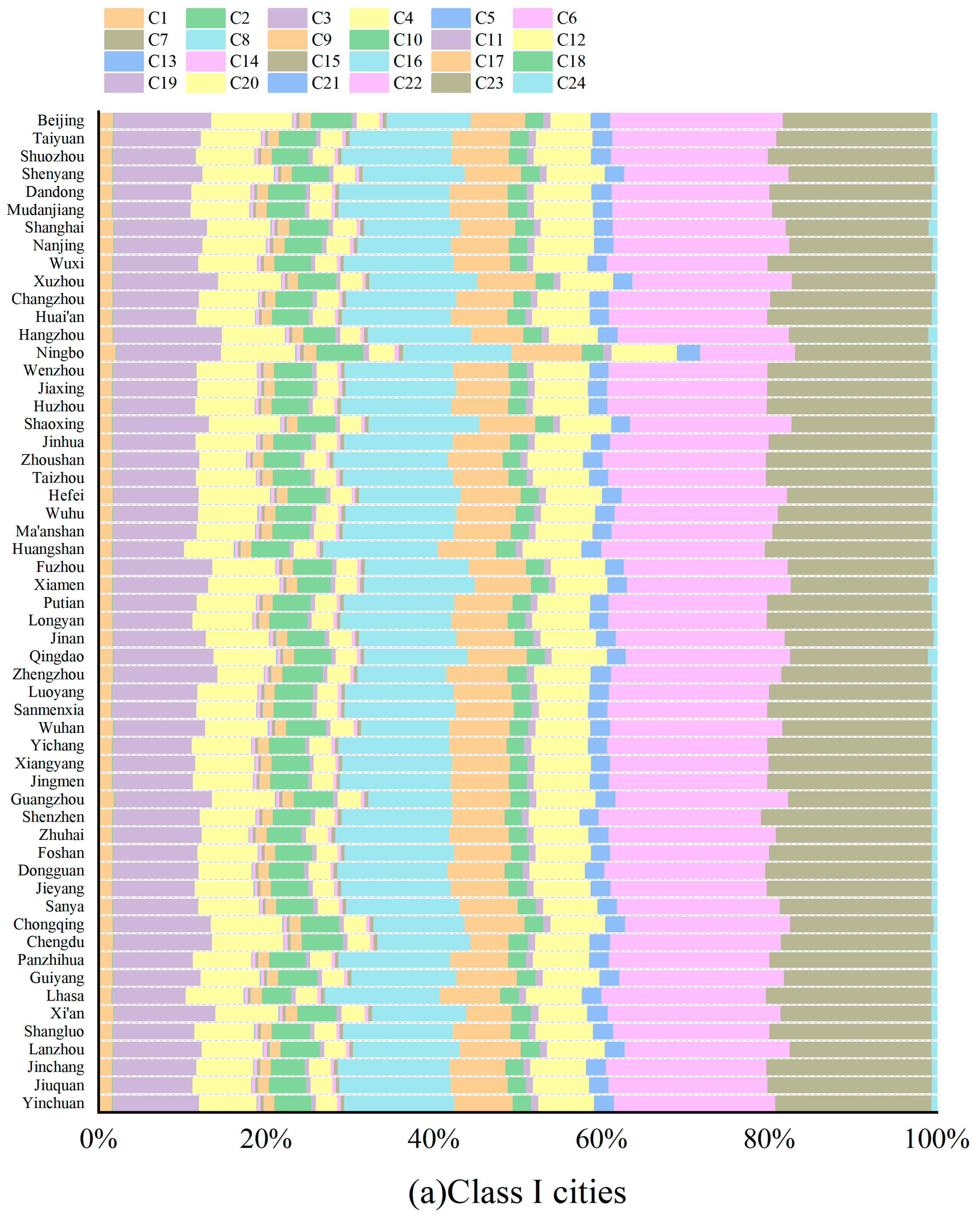
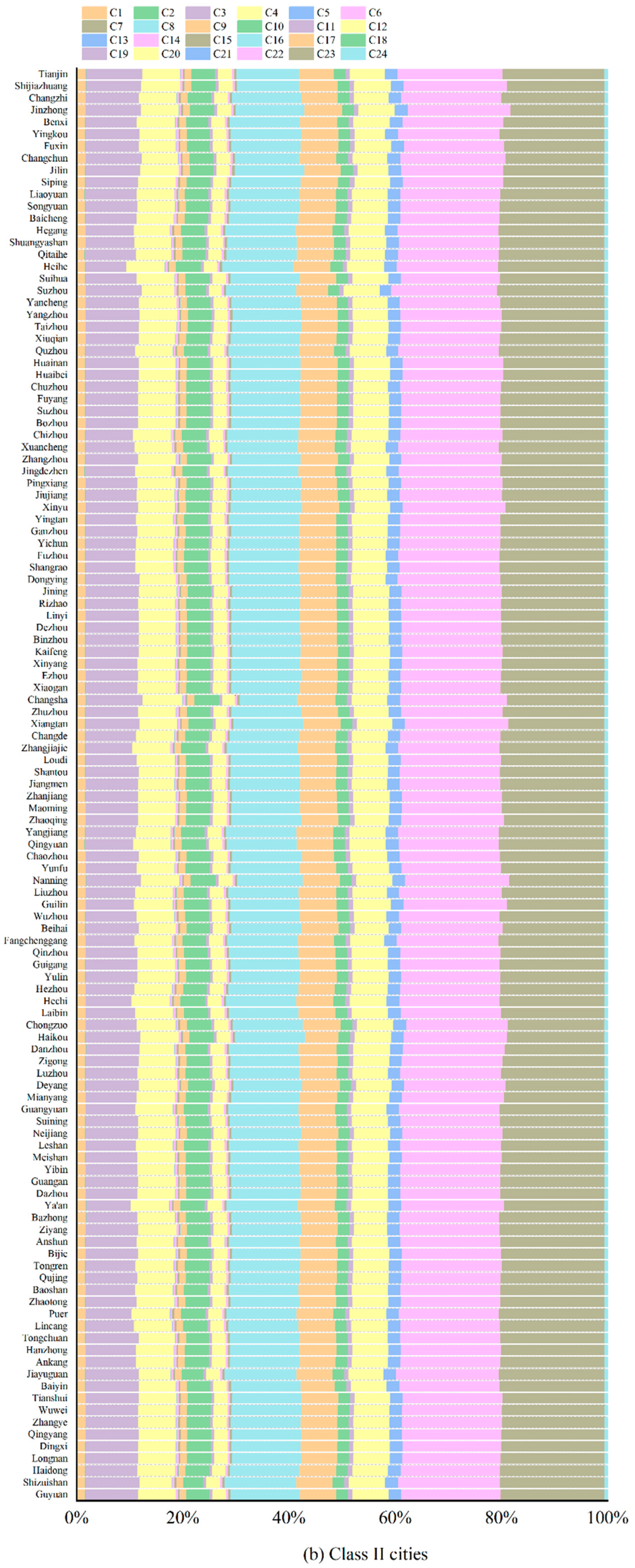
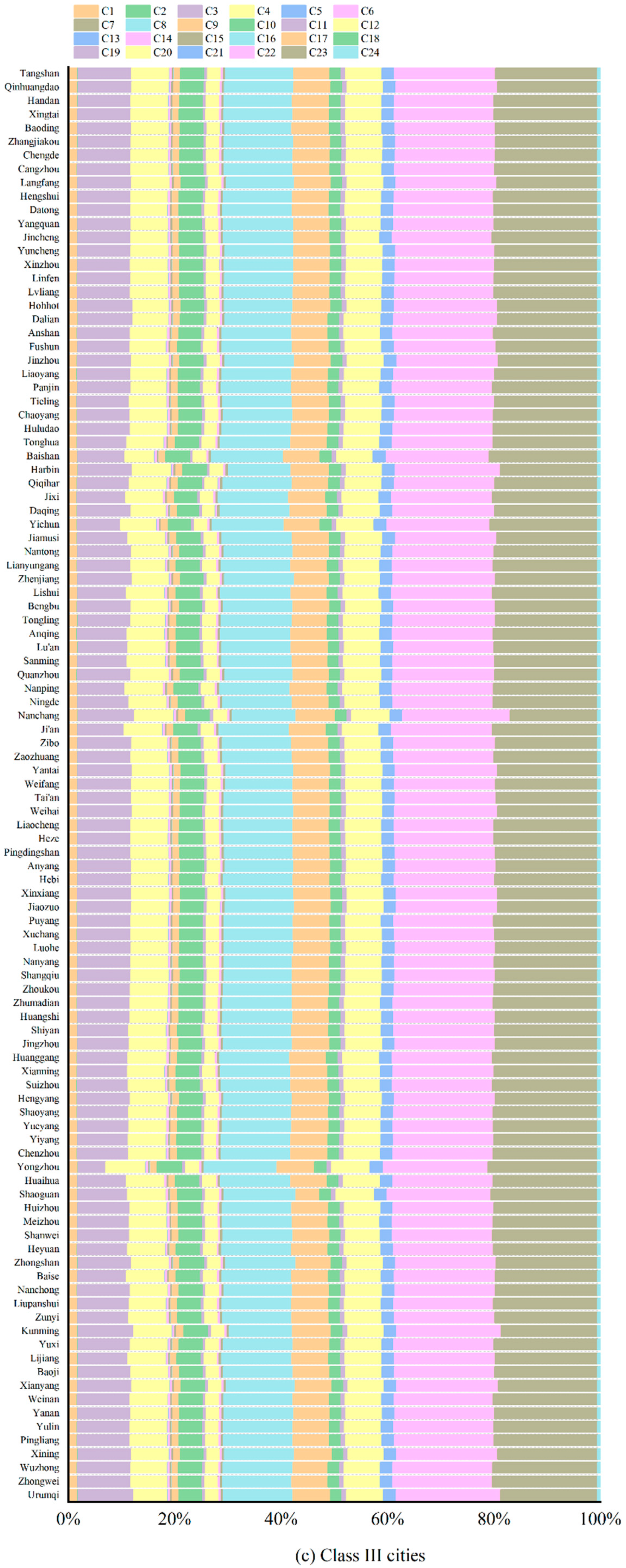
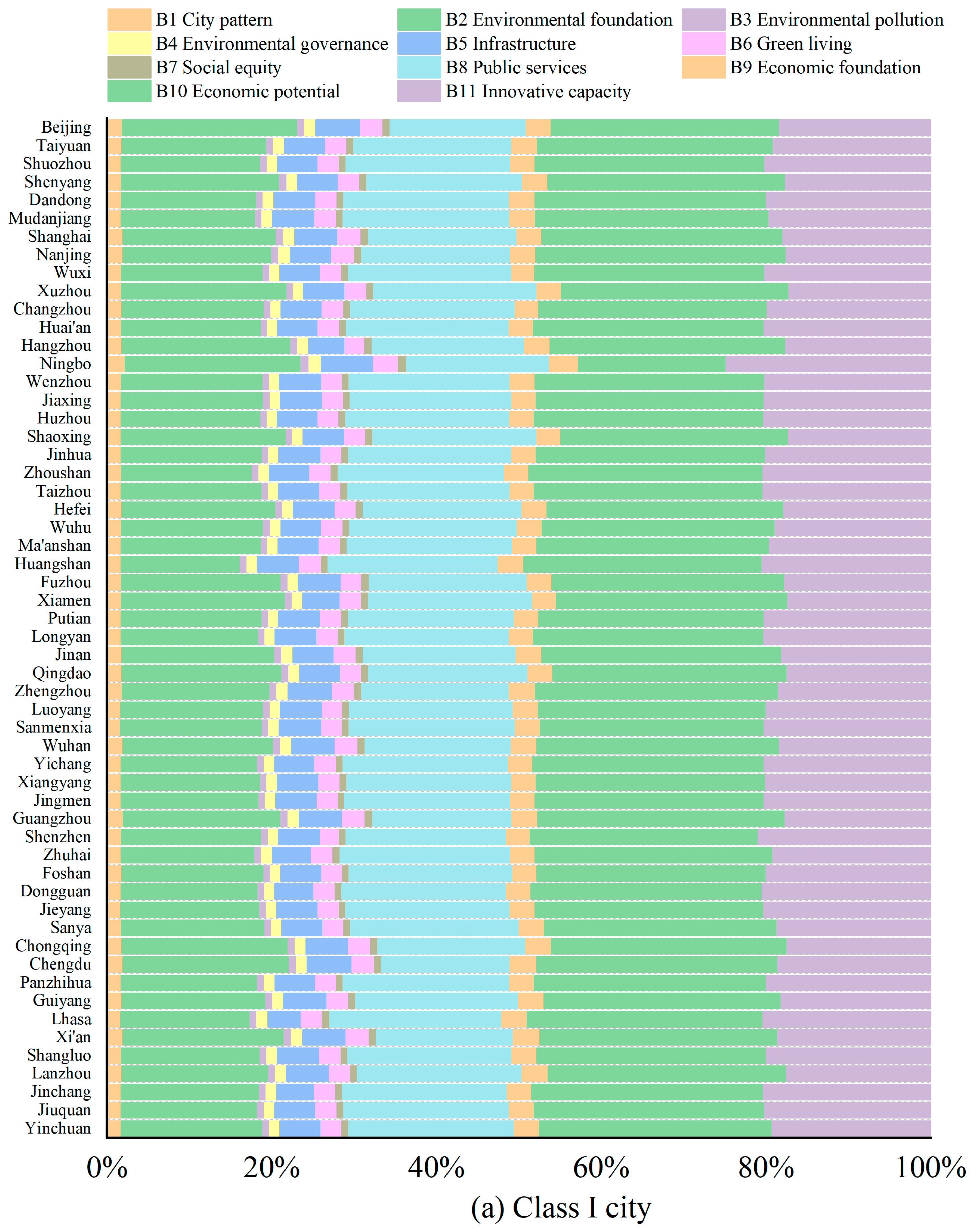
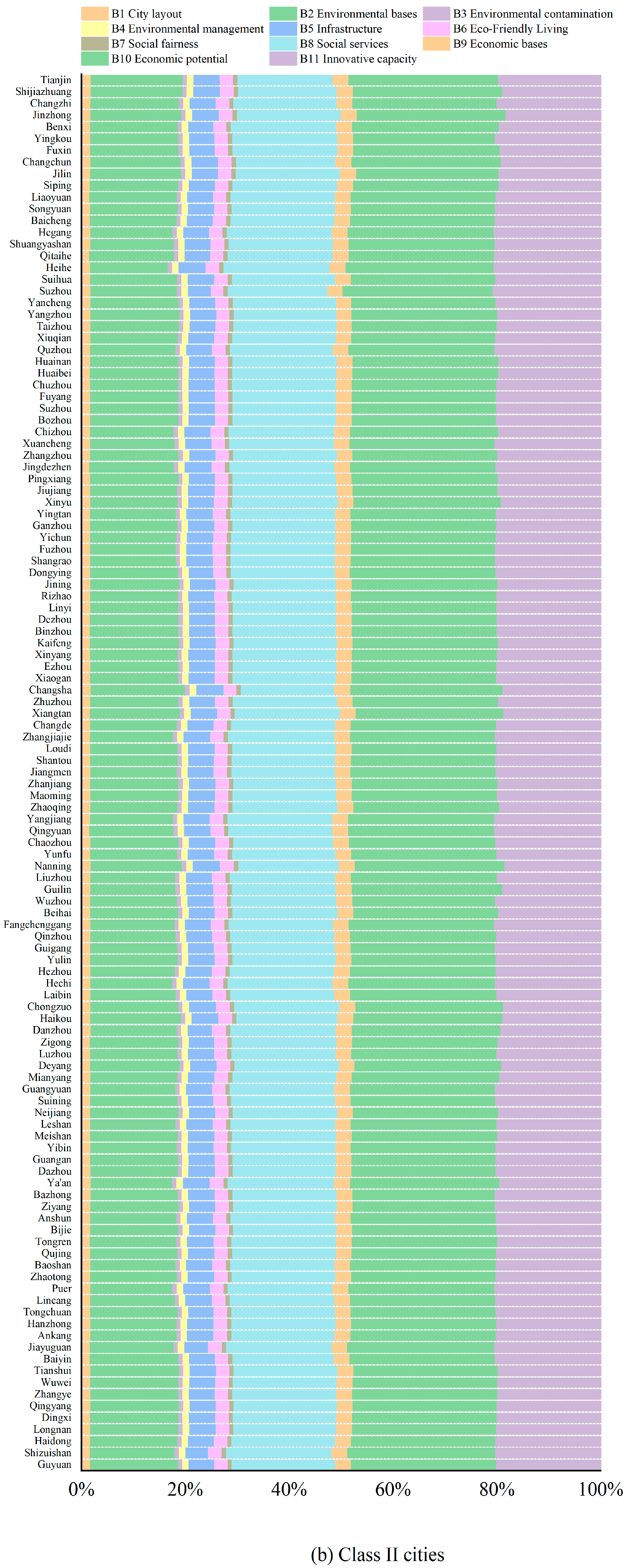
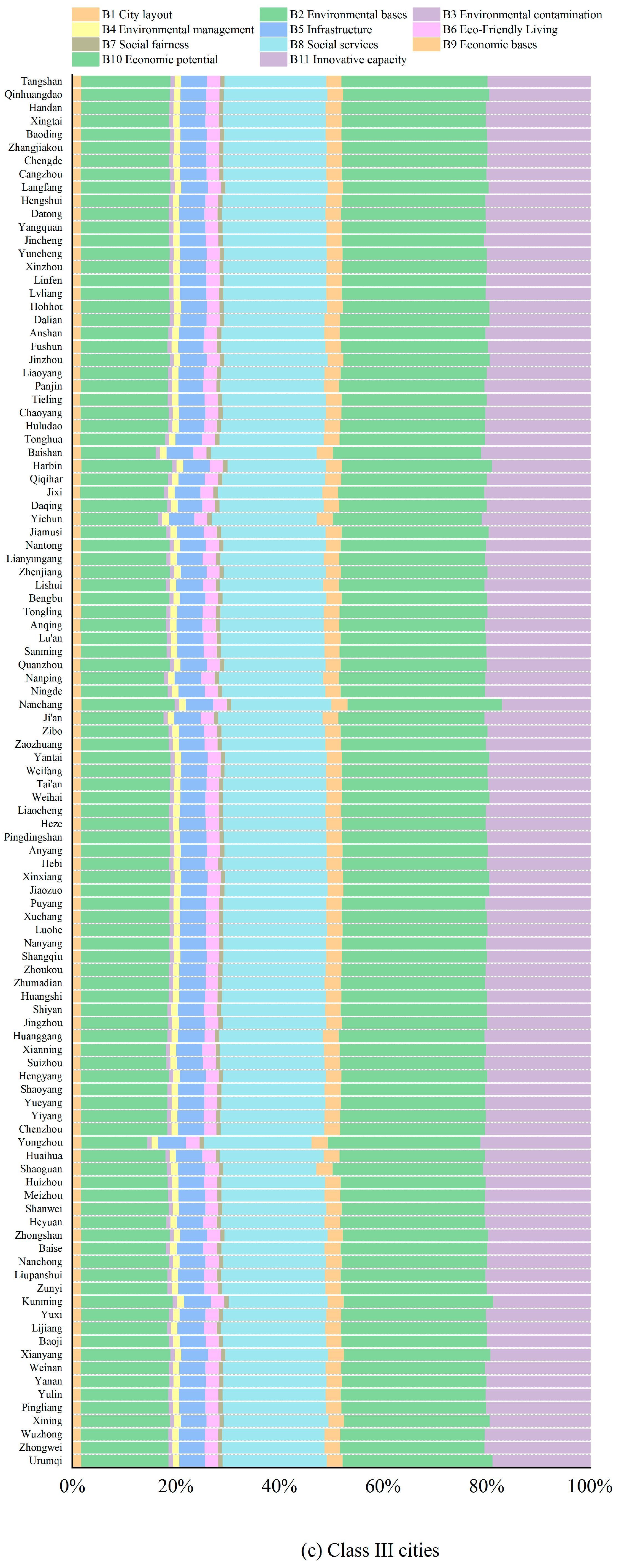
Appendix B
Appendix B.1. K-Means Clustering Method
Appendix B.2. Partial Dependence Plot and Individual Conditional Expectation
References
- Korhonen, J.; Snäkin, J.-P. Quantifying the relationship of resilience and eco-efficiency in complex adaptive energy systems. Ecol. Econ. 2015, 120, 83–92. [Google Scholar] [CrossRef]
- Un-Habitat. World Cities Report 2020: The Value of Sustainable Urbanization; UN: Nairobi, Kenya, 2020.
- Ripple, W.J.; Wolf, C.; Newsome, T.M.; Barnard, P.; Moomaw, W.R. World scientists’ warning of a climate emergency. BioScience 2020, 70, 8–100. [Google Scholar] [CrossRef]
- Lin, Z. Ecological urbanism in East Asia: A comparative assessment of two eco-cities in Japan and China. Landsc. Urban Plan. 2018, 179, 90–102. [Google Scholar] [CrossRef]
- Du, S.; Zhang, X.; Lei, Y.; Huang, X.; Tu, W.; Liu, B.; Meng, Q.; Du, S. Mapping urban functional zones with remote sensing and geospatial big data: A systematic review. GIScience Remote Sens. 2024, 61, 2404900. [Google Scholar] [CrossRef]
- Chen, Y.; Zhu, M.; Lu, J.; Zhou, Q.; Ma, W. Evaluation of ecological city and analysis of obstacle factors under the background of high-quality development: Taking cities in the Yellow River Basin as examples. Ecol. Indic. 2020, 118, 106771. [Google Scholar] [CrossRef]
- Han, L. Relationship between urbanization and urban air quality: An insight on fine particulate dynamics in China. Prog. Geogr. 2018, 37, 1011–1021. [Google Scholar]
- Du, S.; Zheng, M.; Guo, L.; Wu, Y.; Li, Z.; Liu, P. Urban building function classification based on multisource geospatial data: A two-stage method combining unsupervised and supervised algorithms. Earth Sci. Inform. 2024, 17, 1179–1201. [Google Scholar] [CrossRef]
- Meng, F.; Guo, J.; Guo, Z.; Lee, J.C.; Liu, G.; Wang, N. Urban ecological transition: The practice of ecological civilization construction in China. Sci. Total Environ. 2021, 755, 142633. [Google Scholar] [CrossRef]
- Hu, M.-C.; Wadin, J.L.; Lo, H.-C.; Huang, J.-Y. Transformation toward an eco-city: Lessons from three Asian cities. J. Clean. Prod. 2016, 123, 77–87. [Google Scholar] [CrossRef]
- Sachs, J.D.; Schmidt-Traub, G.; Mazzucato, M.; Messner, D.; Nakicenovic, N.; Rockström, J. Six Transformations to achieve the Sustainable Development Goals. Nat. Sustain. 2019, 2, 805–814. [Google Scholar] [CrossRef]
- Lan, T.; Shao, G.; Xu, Z.; Tang, L.; Dong, H. Considerable role of urban functional form in low-carbon city development. J. Clean. Prod. 2023, 392, 136256. [Google Scholar] [CrossRef]
- Zhang, X.; Xu, X.; Pan, S.; Mo, Y.; Dong, C. Exploring the impact of low-carbon city pilot policy on urban ecological welfare performance: A quasi-natural experiment in 282 Chinese cities. Urban Clim. 2024, 58, 102216. [Google Scholar] [CrossRef]
- Howard, E. Tomorrow: A Peaceful Path to Real Reform; Swan Sonnenschein; Routledge: London, UK, 1898. [Google Scholar]
- Li, Z. How to Build Eco-City in China. Nat. Ecol. Conserv. 2002, 27–29. [Google Scholar] [CrossRef]
- Kaushal, S.S.; Belt, K.T. The urban watershed continuum: Evolving spatial and temporal dimensions. Urban Ecosyst. 2012, 15, 409–435. [Google Scholar] [CrossRef]
- Vergnes, A.; Le Viol, I.; Clergeau, P. Green corridors in urban landscapes affect the arthropod communities of domestic gardens. Biol. Conserv. 2012, 145, 171–178. [Google Scholar] [CrossRef]
- Xu, L.; Yao, S.; Chen, S.; Xu, Y. Evaluation of Eco-city Under the Concept of High-quality Development:A Case Study of the Yangtze River Delta Urban Agglomeration. Sci. Geogr. Sin. 2019, 39, 1228–1237. [Google Scholar] [CrossRef]
- Wang, J.; Wei, X.; Guo, Q. A three-dimensional evaluation model for regional carrying capacity of ecological environment to social economic development: Model development and a case study in China. Ecol. Indic. 2018, 89, 348–355. [Google Scholar] [CrossRef]
- Cao, L.; Hao, S.; Chen, N. Building and Evaluation of the Rural Ecological Environment Index System. Res. Soil Water Conserv. 2010, 17, 238–240+244. [Google Scholar] [CrossRef]
- Tan, S. Research on evaluation of ecological livable city based on residents’ satisfaction—Take Zhuzhou as an example. Eco Cities 2022, 3, 1–12. [Google Scholar] [CrossRef]
- Al-Harbi, K.M.A.-S. Application of the AHP in project management. Int. J. Proj. Manag. 2001, 19, 19–27. [Google Scholar] [CrossRef]
- Kwong, C.K.; Ip, W.; Chan, J. Combining scoring method and fuzzy expert systems approach to supplier assessment: A case study. Integr. Manuf. Syst. 2002, 13, 512–519. [Google Scholar] [CrossRef]
- Zou, Z.-H.; Yi, Y.; Sun, J.-N. Entropy method for determination of weight of evaluating indicators in fuzzy synthetic evaluation for water quality assessment. J. Environ. Sci. 2006, 18, 1020–1023. [Google Scholar] [CrossRef]
- Vu, T.T.H.; Tian, G.; Khan, N.; Zada, M.; Zhang, B.; Nguyen, T.V. Evaluating the international competitiveness of Vietnam wood processing industry by combining the variation coefficient and the entropy method. Forests 2019, 10, 901. [Google Scholar] [CrossRef]
- Han, B.; Liu, H.; Wang, R. Urban ecological security assessment for cities in the Beijing–Tianjin–Hebei metropolitan region based on fuzzy and entropy methods. Ecol. Model. 2015, 318, 217–225. [Google Scholar] [CrossRef]
- Ericsson, M.; Resende, M.G.C.; Pardalos, P.M. A genetic algorithm for the weight setting problem in OSPF routing. J. Comb. Optim. 2002, 6, 299–333. [Google Scholar] [CrossRef]
- Belgiu, M.; Drăguţ, L. Random forest in remote sensing: A review of applications and future directions. ISPRS J. Photogramm. Remote Sens. 2016, 114, 24–31. [Google Scholar] [CrossRef]
- Zhao, L.Q.; van Duynhoven, A.; Dragićević, S. Machine Learning for Criteria Weighting in GIS-Based Multi-Criteria Evaluation: A Case Study of Urban Suitability Analysis. Land 2024, 13, 1288. [Google Scholar] [CrossRef]
- Hu, P. Evaluation algorithm of coastal city ecological civilization development level based on improved BP neural network. J. Environ. Manag. 2022, 321, 116039. [Google Scholar] [CrossRef] [PubMed]
- Xie, Y.; Dai, W.; Xiang, S.; Deng, H.; Wang, Z.; Li, Y.; Wang, Z.; Zhou, M.; Gao, M. Supply and demand of ecosystem services and their interaction with urbanization: The case of Chengdu-Chongqing urban agglomeration. Urban Clim. 2024, 55, 101978. [Google Scholar] [CrossRef]
- Carli, R.; Dotoli, M.; Pellegrino, R. Multi-criteria decision-making for sustainable metropolitan cities assessment. J. Environ. Manag. 2018, 226, 46–61. [Google Scholar] [CrossRef] [PubMed]
- Xu, D.; Zhu, D.; Deng, Y.; Sun, Q.; Ma, J.; Liu, F. Evaluation and empirical study of Happy River on the basis of AHP: A case study of Shaoxing City (Zhejiang, China). Mar. Freshw. Res. 2023, 74, 838–850. [Google Scholar] [CrossRef]
- Zhang, S.; Liu, S.; Zhong, Q.; Zhu, K.; Fu, H. Assessing Eco-Environmental Effects and Its Impacts Mechanisms in the Mountainous City: Insights from Ecological–Production–Living Spaces Using Machine Learning Models in Chongqing. Land 2024, 13, 1196. [Google Scholar] [CrossRef]
- Yang, C.; Zeng, W.; Yang, X. Coupling coordination evaluation and sustainable development pattern of geo-ecological environment and urbanization in Chongqing municipality, China. Sustain. Cities Soc. 2020, 61, 102271. [Google Scholar] [CrossRef]
- Yao, X.-J.; Zheng, W.; Wang, D.-C.; An, M.; Wang, X.-Y.; Chen, W.; Wang, W.; Chi, T.-H. Micro-scale habitability evaluation of Sino-Singapore Tianjin Eco-city based on multi-source data. Ying Yong Sheng Tai Xue Bao J. Appl. Ecol. 2022, 33, 2493–2500. [Google Scholar] [CrossRef]
- Liang, Z.; Zhang, M.; Mao, Q.; Yu, B.; Ma, B. Improvement of eco-efficiency in China: A comparison of mandatory and hybrid environmental policy instruments. Int. J. Environ. Res. Public Health 2018, 15, 1473. [Google Scholar] [CrossRef] [PubMed]
- Zhong, L.; Li, X.; Law, R.; Sun, S. Developing Sustainable Urbanization Index: Case of China. Sustainability 2020, 12, 4585. [Google Scholar] [CrossRef]
- Zhu, J.; Lu, X. Mechanism of impact and spatial effects of digital economy in enhancing tourism economic resilience. Prog. Geogr. 2024, 43, 2004–2020. [Google Scholar] [CrossRef]
- Miao, L.; Tang, S.; Li, X.; Yu, D.; Deng, Y.; Hang, T.; Yang, H.; Liang, Y.; Kwan, M.-P.; Huang, L. Estimating the CO2 emissions of Chinese cities from 2011 to 2020 based on SPNN-GNNWR. Environ. Res. 2023, 218, 115060. [Google Scholar] [CrossRef]
- Zhang, W.; Wang, Y.; Wei, R. Spatiotemporal evolution and mechanism about high-quality development convergence clubs of cities within urban agglomerations. Acta Geogr. Sin. 2023, 78, 3109–3128. [Google Scholar] [CrossRef]
- Hu, X.; Ma, C.; Huang, P.; Guo, X. Ecological vulnerability assessment based on AHP-PSR method and analysis of its single parameter sensitivity and spatial autocorrelation for ecological protection–A case of Weifang City, China. Ecol. Indic. 2021, 125, 107464. [Google Scholar] [CrossRef]
- Liu, Z.; Xie, Q.; Dai, L.; Wang, H.; Deng, L.; Wang, C.; Zhang, Y.; Zhou, X.; Yang, C.; Xiang, C. Research on comprehensive evaluation method of distribution network based on AHP-entropy weighting method. Front. Energy Res. 2022, 10, 975462. [Google Scholar] [CrossRef]
- Na, W.; Zhao, Z. The comprehensive evaluation method of low-carbon campus based on analytic hierarchy process and weights of entropy. Environ. Dev. Sustain. 2021, 23, 9308–9319. [Google Scholar] [CrossRef]
- Chen, C.-H. A novel multi-criteria decision-making model for building material supplier selection based on entropy-AHP weighted TOPSIS. Entropy 2020, 22, 259. [Google Scholar] [CrossRef]
- Wątróbski, J.; Bączkiewicz, A.; Ziemba, E.; Sałabun, W. Sustainable cities and communities assessment using the DARIA-TOPSIS method. Sustain. Cities Soc. 2022, 83, 103926. [Google Scholar] [CrossRef]
- Zhao, R.; Fang, C.; Liu, J.; Zhang, L. The evaluation and obstacle analysis of urban resilience from the multidimensional perspective in Chinese cities. Sustain. Cities Soc. 2022, 86, 104160. [Google Scholar] [CrossRef]
- Zhou, S.; Zhang, M.; Wang, S.; Sun, M. Assessment of vulnerability in natural-social system in Hexi, Gansu. Resour. Sci. 2018, 40, 452–462. [Google Scholar]
- Sinaga, K.P.; Yang, M.-S. Unsupervised K-means clustering algorithm. IEEE Access 2020, 8, 80716–80727. [Google Scholar] [CrossRef]
- Goldstein, A.; Kapelner, A.; Bleich, J.; Pitkin, E. Peeking inside the black box: Visualizing statistical learning with plots of individual conditional expectation. J. Comput. Graph. Stat. 2015, 24, 44–65. [Google Scholar] [CrossRef]
- Brunsdon, C.; Fotheringham, A.S.; Charlton, M.E. Geographically weighted regression: A method for exploring spatial nonstationarity. Geogr. Anal. 1996, 28, 281–298. [Google Scholar] [CrossRef]
- Saputra, D.M.; Saputra, D.; Oswari, L.D. Effect of distance metrics in determining k-value in k-means clustering using elbow and silhouette method. In Proceedings of the Sriwijaya International Conference on Information Technology and Its Applications (SICONIAN 2019), Palembang, South Sumatra, Indonesia, 16 November 2019; pp. 341–346. [Google Scholar]
- Borgonovo, E.; Plischke, E. Sensitivity analysis: A review of recent advances. Eur. J. Oper. Res. 2016, 248, 869–887. [Google Scholar] [CrossRef]
- Molnar, C. Interpretable Machine Learning; Lulu Press, Inc.: Durham, UK, 2020. [Google Scholar]
- Rao, A.S. Saturation effects in nonlinear absorption, refraction, and frequency conversion: A review. Optik 2022, 267, 169638. [Google Scholar] [CrossRef]
- Wang, S.; Psaraftis, H.N.; Qi, J. Paradox of international maritime organization’s carbon intensity indicator. Commun. Transp. Res. 2021, 1, 100005. [Google Scholar] [CrossRef]
- Wang, H.; Liu, P. Spatial correlation network of renewable energy consumption and its influencing factors: Evidence from 31 Chinese provinces. Renew. Energy 2023, 217, 119173. [Google Scholar] [CrossRef]
- Wang, S.; Ma, Y. Influencing factors and regional discrepancies of the efficiency of carbon dioxide emissions in Jiangsu, China. Ecol. Indic. 2018, 90, 460–468. [Google Scholar] [CrossRef]
- Huang, X.; Wang, Y. Investigating the effects of 3D urban morphology on the surface urban heat island effect in urban functional zones by using high-resolution remote sensing data: A case study of Wuhan, Central China. ISPRS J. Photogramm. Remote Sens. 2019, 152, 119–131. [Google Scholar] [CrossRef]
- Guan, X.; Wang, J.; Xiao, F. Sponge city strategy and application of pavement materials in sponge city. J. Clean. Prod. 2021, 303, 127022. [Google Scholar] [CrossRef]
- Gong, X.; Zhang, X.; Tao, J.; Li, H.; Zhang, Y. An evaluation of the development performance of small county towns and its influencing factors: A case study of small towns in Jiangyin City in the Yangtze River Delta, China. Land 2022, 11, 1059. [Google Scholar] [CrossRef]
- Li, J.; Liu, S.; Peng, B.; Ye, H.; Zhang, Z. Identification and Optimization of County-Level Ecological Spaces under the Dual-Carbon Target: A Case Study of Shaanxi Province, China. Remote Sens. 2023, 15, 4009. [Google Scholar] [CrossRef]
- Zhong, M.; Liu, Q.; Hu, X. Understanding the county-level relationship between population change and ecological environment quality dynamic in China, 2000–2020. Front. Environ. Sci. 2025, 13, 1513998. [Google Scholar] [CrossRef]

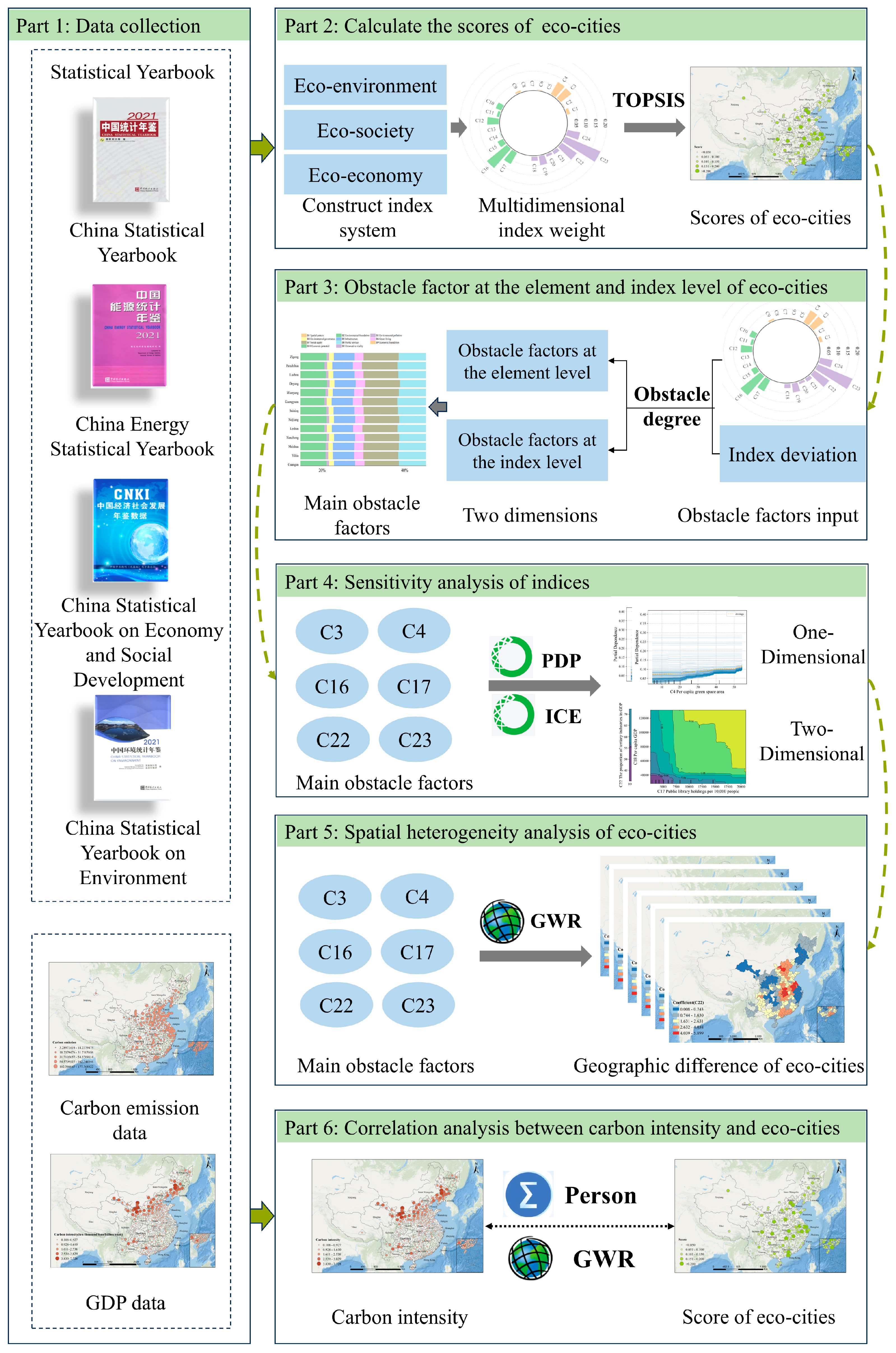


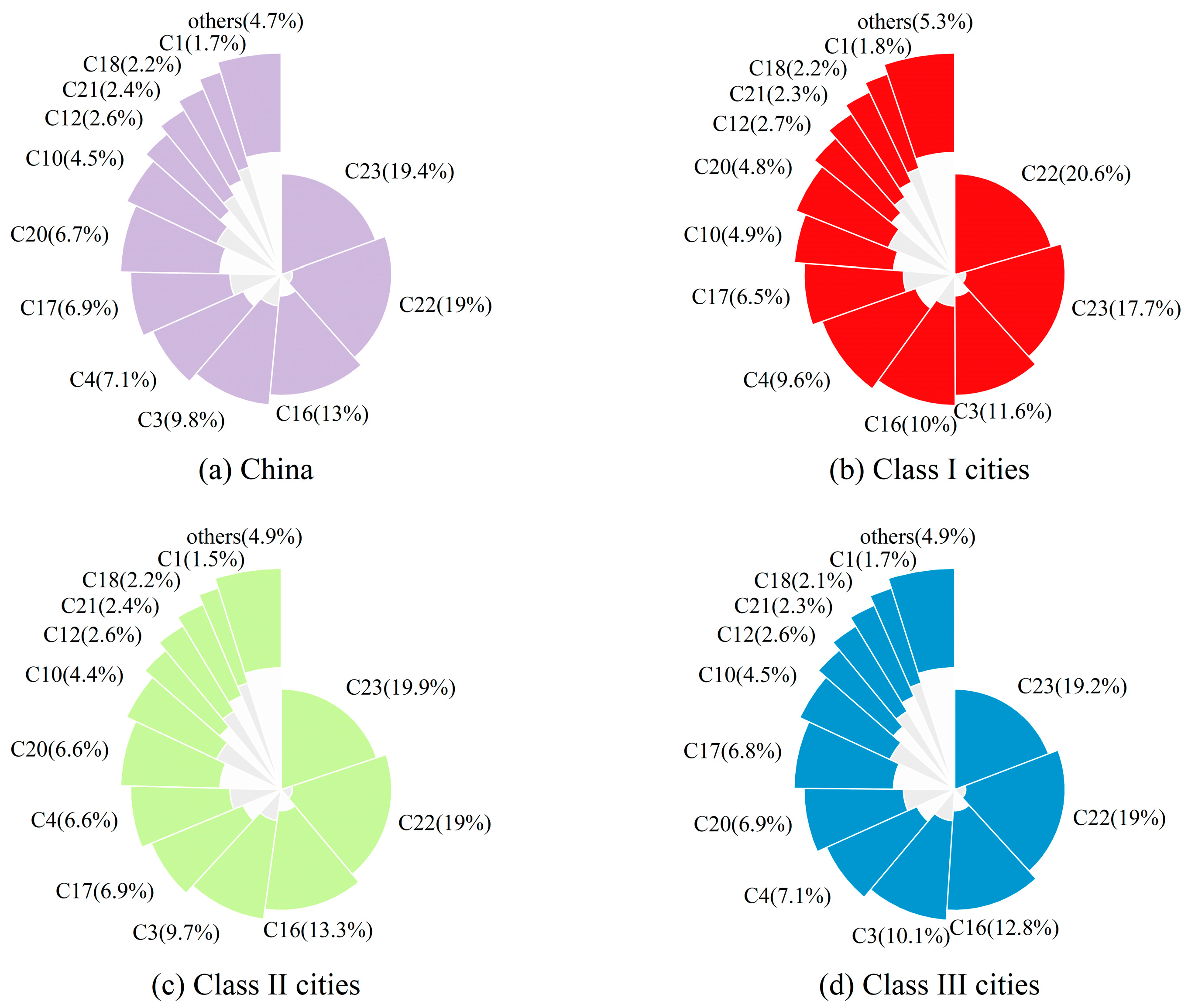
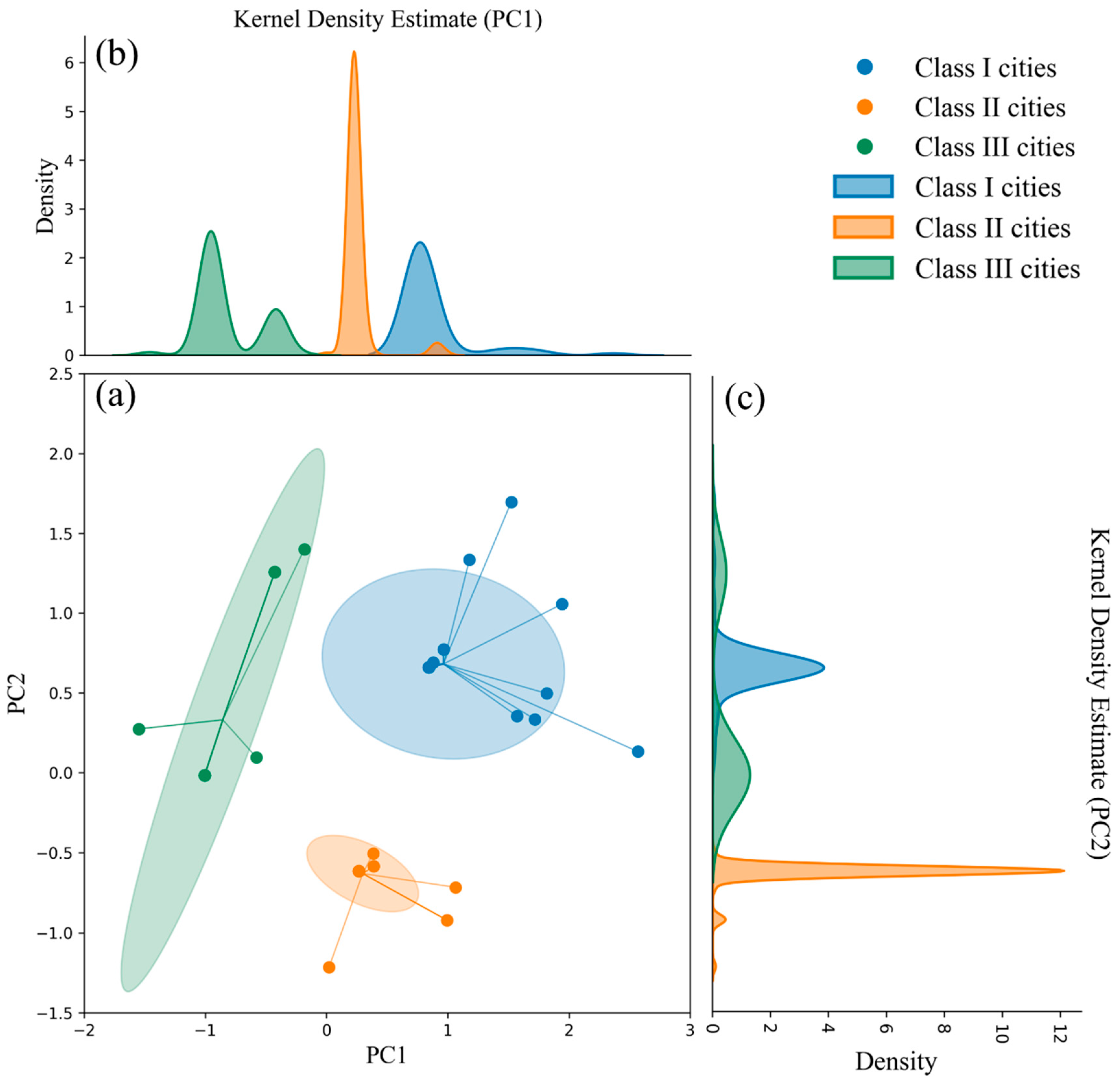
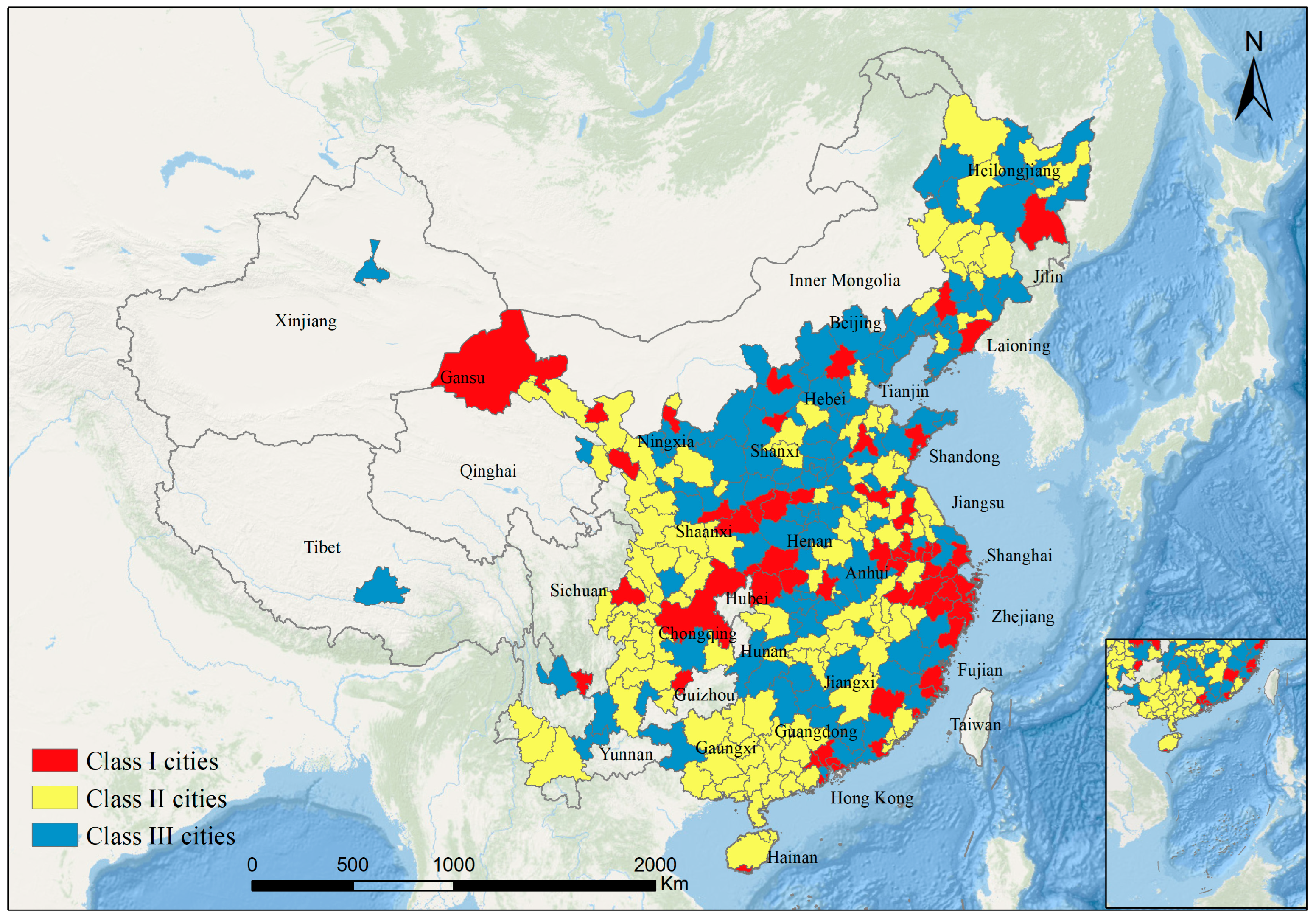
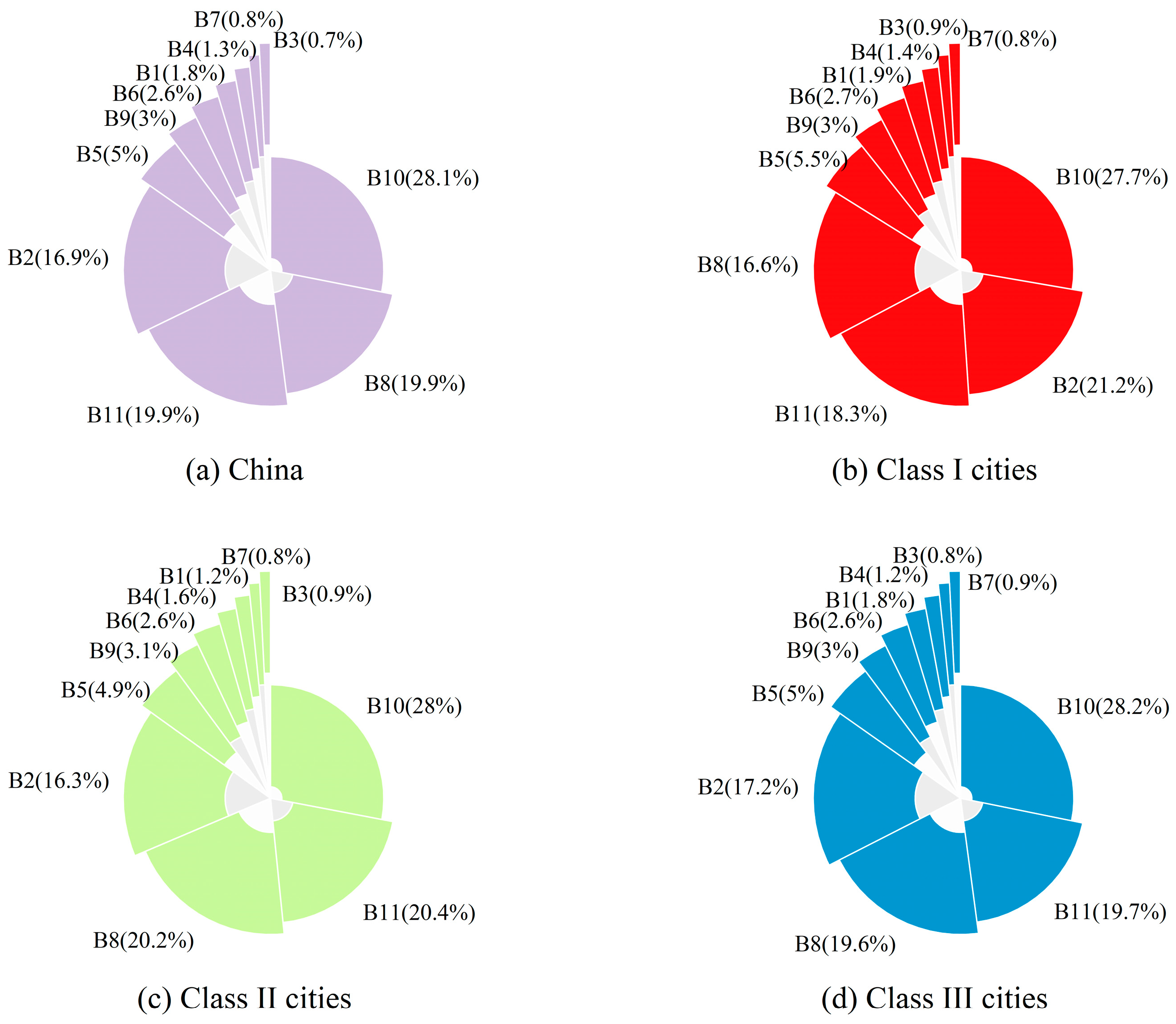
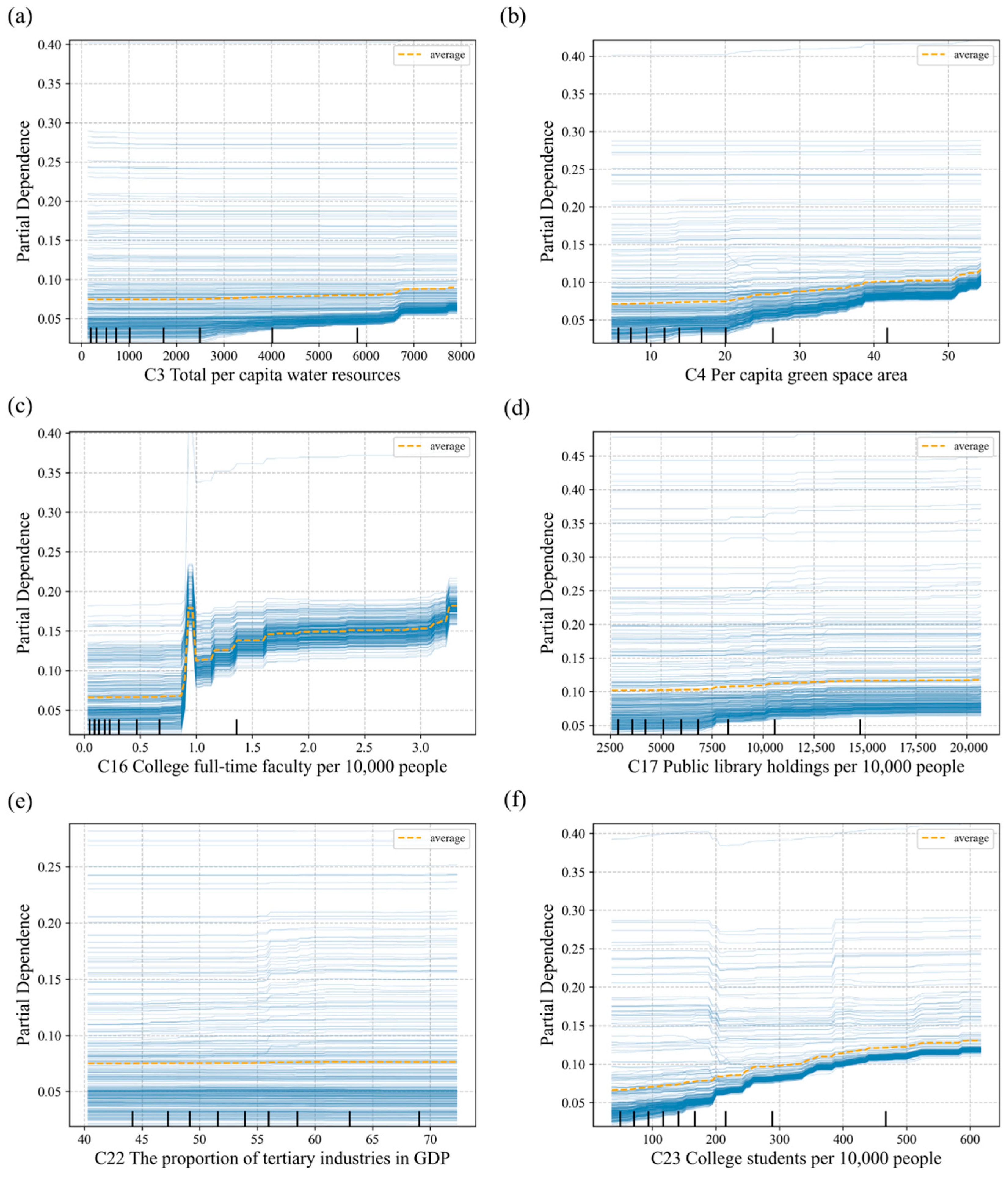
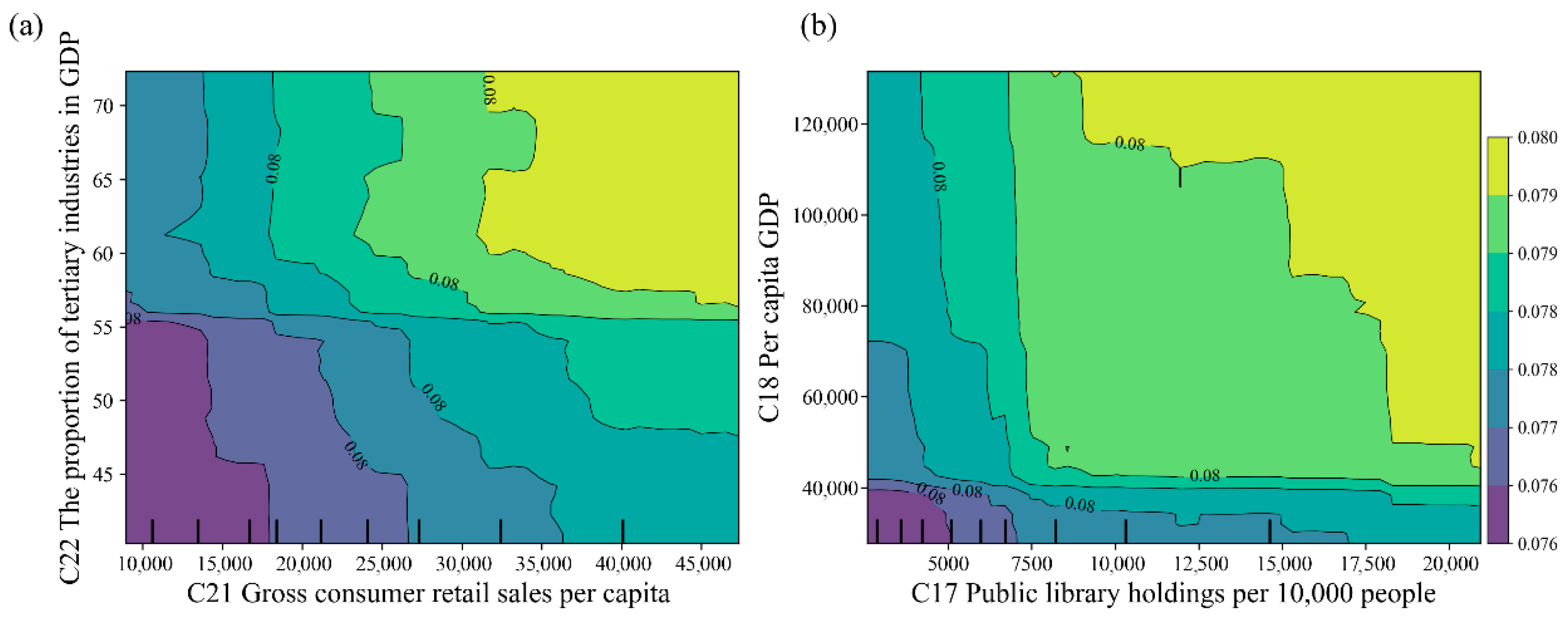
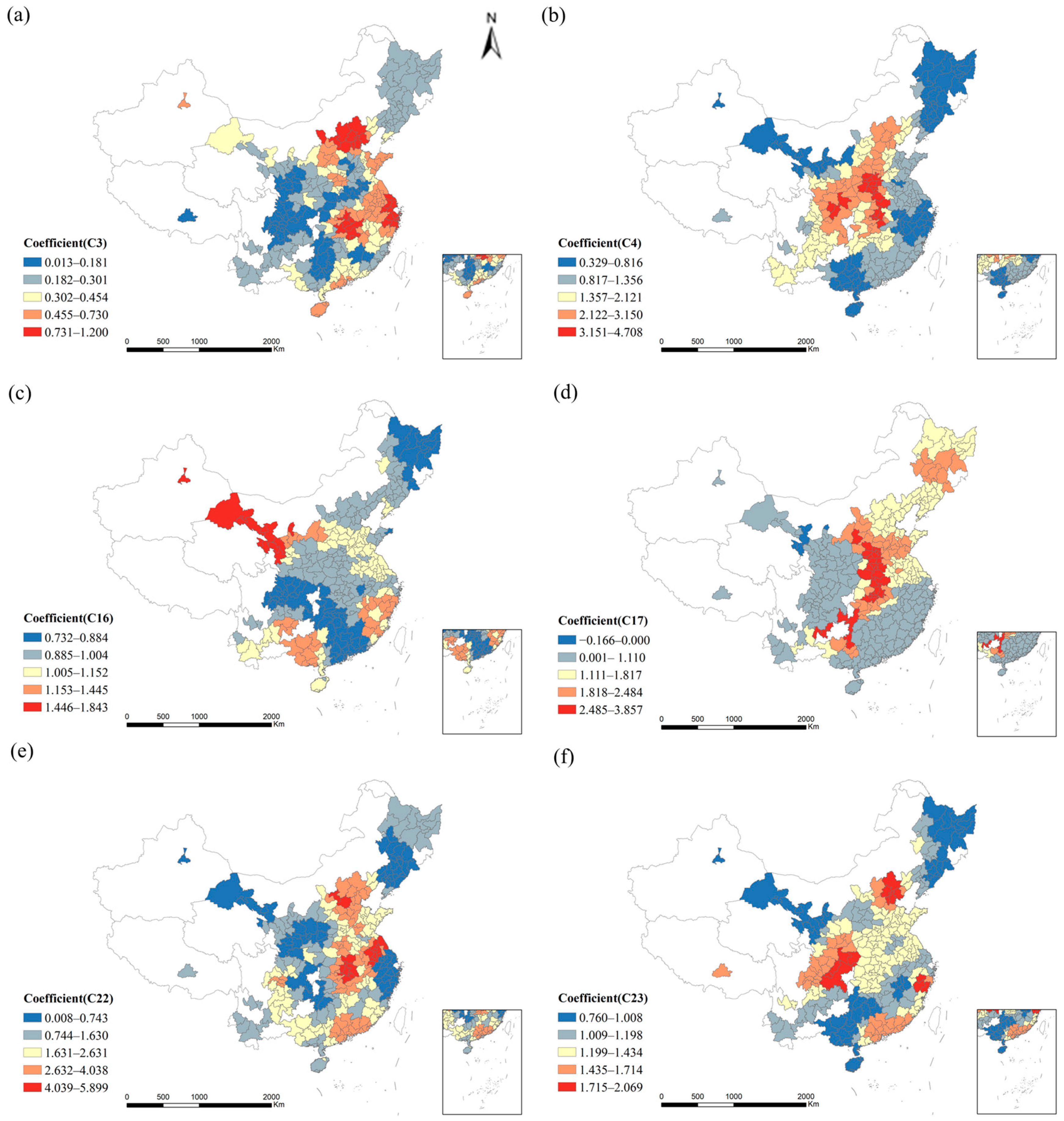
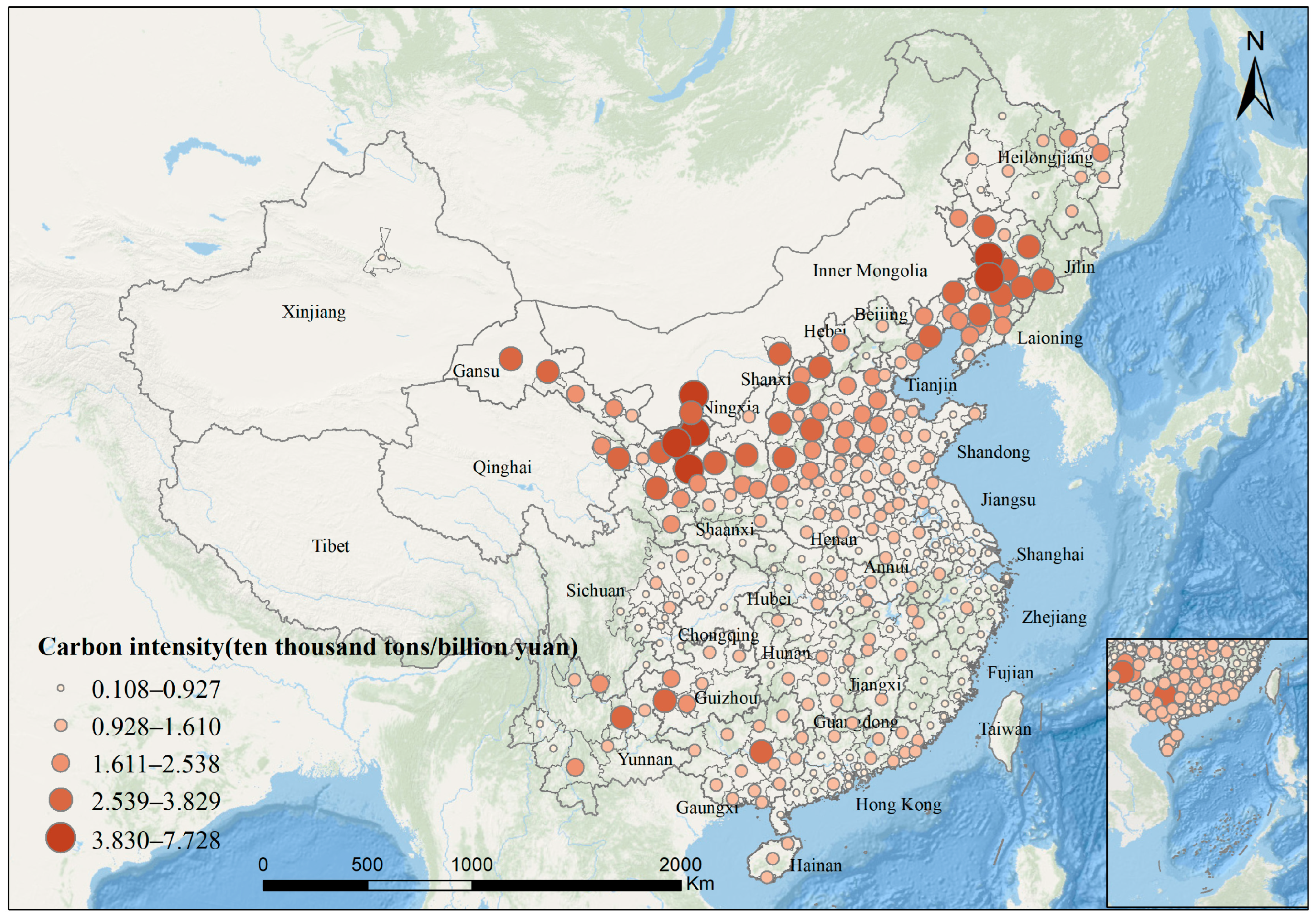
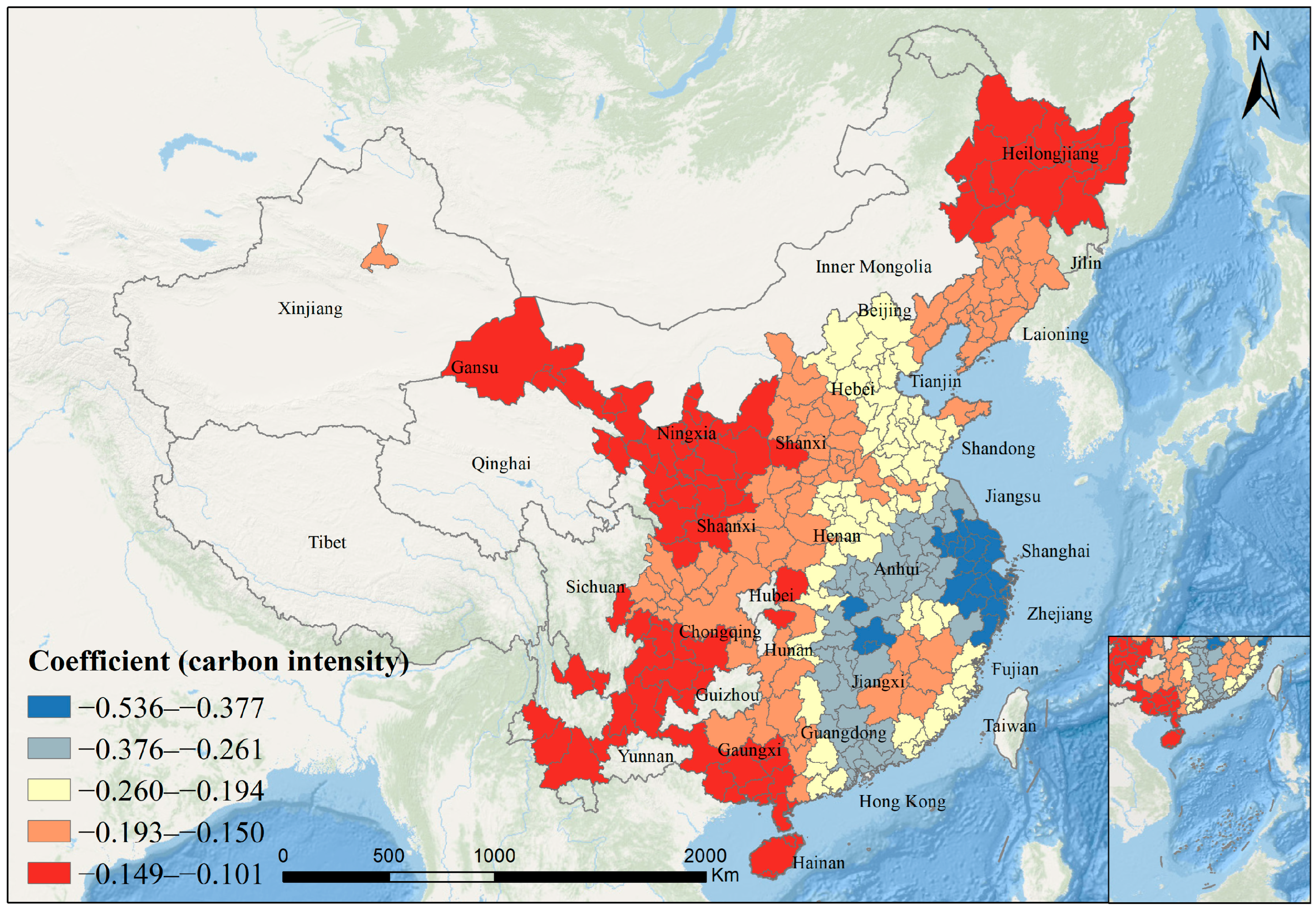
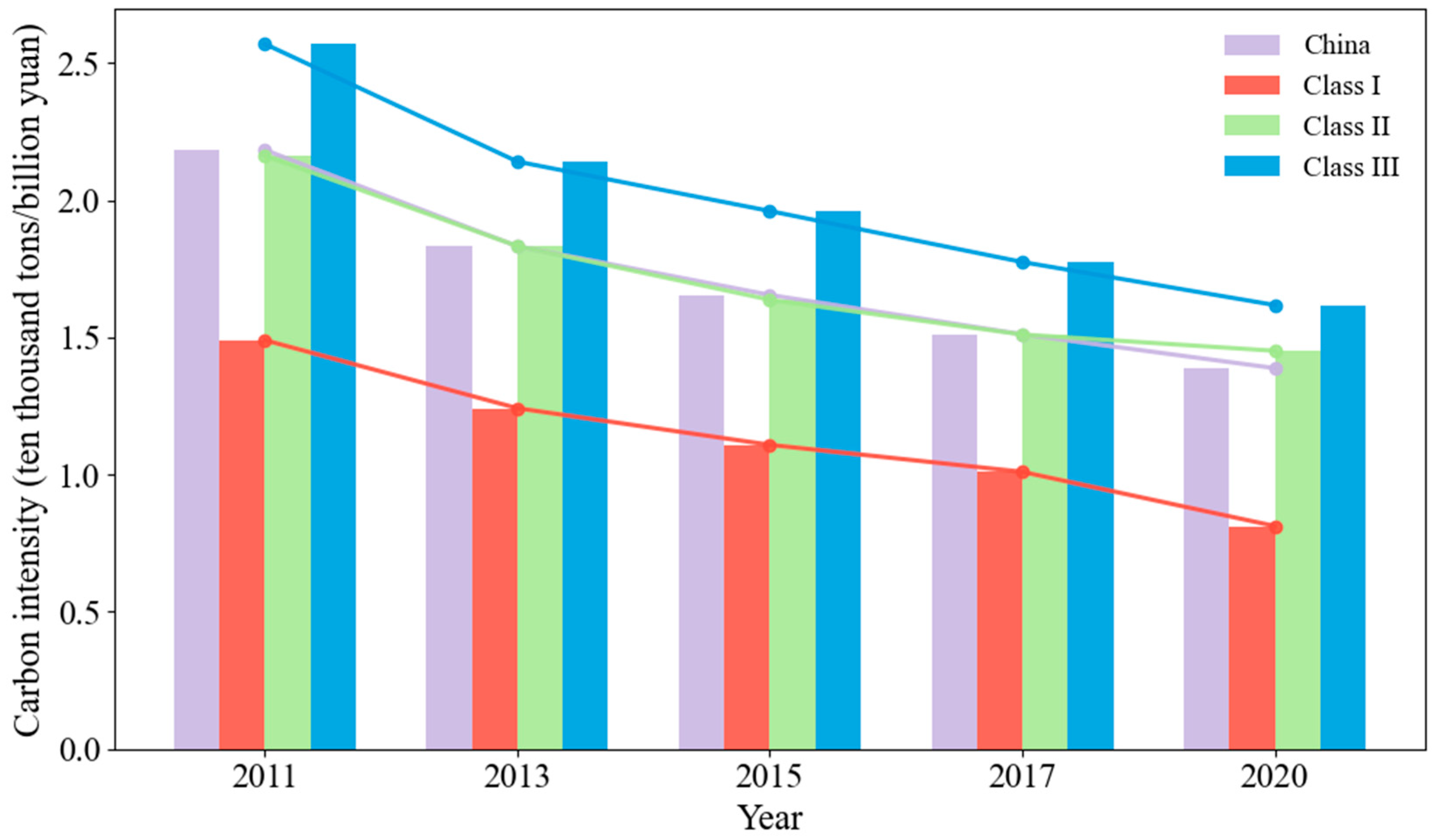
| Dimension | Element | Index | Index Effect |
|---|---|---|---|
| B1 City layout | C1 Per capita living space | + | |
| C2 Green coverage ratio within built-up area | + | ||
| B2 Environmental bases | C3 Total per capita water resources | + | |
| C4 Per capita green space area | + | ||
| A1 Eco- environment | B3 Environmental contamination | C5 Units of industrial wastewater discharged in built-up area | - |
| C6 Sulfur dioxide emissions from industrial sources in built-up area | - | ||
| C7 Units of industrial dust emissions in built-up area | - | ||
| B4 Environmental management | C8 Effluent treatment rate | + | |
| C9 Integrated utilization rate of industrial solid waste | + | ||
| B5 Infrastructure | C10 Per capita road area | + | |
| C11 Medical beds per 10,000 people | + | ||
| B6 Eco-Friendly Living | C12 Public transportation vehicles per 10,000 people | + | |
| A2 Eco-society | C13 Household waste treatment rate | + | |
| B7 Social fairness | C14 Jobless rate | - | |
| C15 Average wage per employee | + | ||
| B8 Social services | C16 College full-time faculty per 10,000 people | + | |
| C17 Public library holdings per 10,000 people | + | ||
| B9 Economic bases | C18 Per capita GDP | + | |
| C19 Revenue per capita | + | ||
| A3 Eco- economy | B10 Economic potential | C20 Fixed asset investment assets per capita | + |
| C21 Gross consumer retail sales per capita | + | ||
| C22 The proportion of tertiary industries in GDP | + | ||
| B11 Innovative capacity | C23 College students per 10,000 people | + | |
| C24 The proportion of education, science, and technology expenditures in local government spending | + |
Disclaimer/Publisher’s Note: The statements, opinions and data contained in all publications are solely those of the individual author(s) and contributor(s) and not of MDPI and/or the editor(s). MDPI and/or the editor(s) disclaim responsibility for any injury to people or property resulting from any ideas, methods, instructions or products referred to in the content. |
© 2025 by the authors. Licensee MDPI, Basel, Switzerland. This article is an open access article distributed under the terms and conditions of the Creative Commons Attribution (CC BY) license (https://creativecommons.org/licenses/by/4.0/).
Share and Cite
Wu, Y.; Fan, D.; Cui, Y.; Du, S.; Sun, W.; Guo, L.; Liu, C. A National-Scale Evaluation of Eco-City Development in China: Spatial Heterogeneity, Obstacle Factors, and Relationship with Carbon Intensity. Land 2025, 14, 2146. https://doi.org/10.3390/land14112146
Wu Y, Fan D, Cui Y, Du S, Sun W, Guo L, Liu C. A National-Scale Evaluation of Eco-City Development in China: Spatial Heterogeneity, Obstacle Factors, and Relationship with Carbon Intensity. Land. 2025; 14(11):2146. https://doi.org/10.3390/land14112146
Chicago/Turabian StyleWu, Yuhui, Deqin Fan, Yajun Cui, Shouhang Du, Wenbin Sun, Liyuan Guo, and Chunhuan Liu. 2025. "A National-Scale Evaluation of Eco-City Development in China: Spatial Heterogeneity, Obstacle Factors, and Relationship with Carbon Intensity" Land 14, no. 11: 2146. https://doi.org/10.3390/land14112146
APA StyleWu, Y., Fan, D., Cui, Y., Du, S., Sun, W., Guo, L., & Liu, C. (2025). A National-Scale Evaluation of Eco-City Development in China: Spatial Heterogeneity, Obstacle Factors, and Relationship with Carbon Intensity. Land, 14(11), 2146. https://doi.org/10.3390/land14112146




